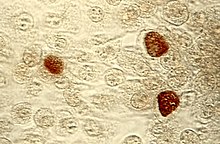Chlamydiaceae
This article needs additional citations for verification. (December 2009) |
| Chlamydiaceae | |
|---|---|

| |
| Chlamydia trachomatis inclusion bodies (brown) in a McCoy cell culture | |
| Scientific classification | |
| Domain: | |
| Phylum: | |
| Class: | |
| Order: | |
| Family: | Chlamydiaceae
|
| Genera | |
|
Candidatus ♠ Karlsen et al. 2008 | |
The Chlamydiaceae are a family of gram-negative bacteria that belongs to the phylum Chlamydiae, order Chlamydiales. Chlamydiaceae species express the family-specific lipopolysaccharide epitope αKdo-(2→8)-αKdo-(2→4)-αKdo (previously called the genus-specific epitope). Chlamydiaceae ribosomal RNA genes all have at least 90% DNA sequence identity. Chlamydiaceae species have varying inclusion morphology, varying extrachromosomal plasmid content, and varying sulfadiazine resistance.
The family Chlamydiaceae currently includes one genus and one candidate genus: Chlamydia and candidatus .[1]
Chlamydia[]
Three species belong to Chlamydia: C. trachomatis, C. muridarum, and C. suis. C. trachomatis has been found only in humans, C. muridarum in hamsters and mice (family Muridae), and C. suis in swine. Chlamydia species produce a small amount of detectable glycogen and have two ribosomal operons.
C. trachomatis is the cause of an infection commonly transmitted sexually (often referred as just "Chlamydia") and also is the cause of trachoma, an infectious eye disease, spread by eye, nose, and throat secretions.
See also[]
| Wikispecies has information related to Chlamydiaceae. |
References[]
- ^ See the NCBI webpage on Chlamydiaceae Data extracted from the "NCBI Taxonomy Browser". National Center for Biotechnology Information. Retrieved 2011-06-05.
- Chlamydiae